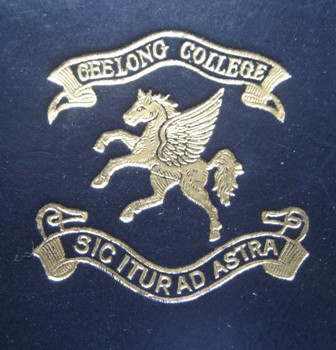
Pegasus Symbol (Detail from Award Bookplate, 1872).
Pegasus, the winged horse of Greek mythology, has been the emblem of Geelong College since the early days of the School’s existence. In the 1961 History of Geelong College it is recorded that Mr Hutton, one of the original two masters with George Morrison, designed the College crest and motto before 1869. Pegasus was the crest of a branch of the Morrison family, as shown in Fairbairn's Book of Crests, and no doubt this was one reason for the choice.
The motto, 'Sic Itur ad Astra', was originally thought to come from the Aeneid, Virgils's account of the journeyings of Aeneas and his family supporters after the fall of Troy. Their journey ultimately ended at the mouth of the Tiber, and two of the sons of Aeneas, Romulus and Remus, are regarded as the founders of Rome. This linking of Greek and Latin sources in the College crest and motto was indicative of George Morrison's belief in the importance of the classics in education.
The name 'Pegasus' was reputed to derive from the Greek word for 'spring', and he was said to have been born 'at the springs of the Ocean' at the time of the slaying of the Gorgon (Medusa) by Perseus, when her blood was fertilised by Poseidon. Thereafter 'Pegasus' flew to Olympus and placed himself at the disposal of Zeus to whom he brought thunderbolts. One of these flights took him to Mount Helicon where, being dry and thirsty, 'Pegasus' struck his hoof against a rock from which flowed a spring, subsequently named Hippocrene. The Muses lived on Mt Helicon and Hippocrene became their favorite place to gather and dance. Later it was the place where Bellepheron captured 'Pegasus' and made him his steed while he performed a number of acts of valour.
.jpg)
Pegasus Symbol and translated poetry
from Pegasus Magazine 1909.
Possibly, this is a translation by George Hutton.

Pegasus Symbol (Award Bookplate Detail, 1908).

Pegasus Symbol (Award Bookplate Detail, 1930).